This post may contain affiliate links. Please see my disclosure policy for details.
There are plenty of Gaudi residences in Barcelona but Casa Batlló has to be the most impressive with its vibrant facade and intriguing design.
Inspired by the legend of St George Slaying the Dragon, this house is often nicknamed the House of Bones as you’ll find skulls and skeletons representing the dragon’s victims.
Visiting is a great way to learn about Gaudi’s art and the cultural footprint his work had in Catalonian society.
Today, it’s one of the most popular attractions in the city and a must for first-time visitors. It’s utterly magical and will take your breath away.
Here is a guide to Barcelona’s House of Bones and things to do in Casa Batlló on your visit!

Top Barcelona Travel Resources
- Book your perfect hotel stay at Booking.com
- Book your tours and attraction tickets with GetYourGuide
- Thinking of renting a car? Look up Rental Cars
- Don’t forget travel insurance, I always use World Nomads
Casa Batlló history
In the 1860s, Barcelona underwent a huge redevelopment project and part of that plan was to transform Passeig de Gracia as the new backbone of the city.
The plan was for the wealthiest families to live on this street so many prominent houses were constructed and put up for sale to the highest bidders.
In 1877, Emilio Sala Cortés designed the original building here who was one of Gaudi’s professors in architecture.
By 1903, Mr Josep Batlló y Casanovas bought the residence. He was a wealthy textile owner and owned several factories around the city.

He then hired Antoni Gaudi to reconstruct the house, giving him free artistic reign over how he wished to design it. His only ask was that Gaudi made it a house that Barcelona couldn’t stop talking about!
Instead of demolishing the existing house built by his professor, Gaudi transformed the existing building into an artistic modernist masterpiece.
He was greatly inspired by the legend of St George slaying the Dragon, giving it the local name of Casa dels ossos (House of Bones) or Casa del Drac (House of the Dragon).

St George Slaying the Dragon
If you thought that Casa Batlló has a fairytale appearance then you wouldn’t be wrong in thinking that. Gaudi inspired the entire design of this house on the legend of St George slaying the Dragon!
You can see the dragon at the very top of the house with shiny scales and St George’s sword piercing its body.
If you look just beneath the dragon at the top row of windows, you can see a flower-shaped princess balcony for the maiden. You can even stand here for a souvenir photo during your visit!
The dragon’s ribcage acts as the supports and the windows have Juliet balconies that resemble skulls.
At the very bottom, the Noble Floor has several pillars to resemble the bone collection of the dragon’s many victims!
That’s why it’s often called the House of Bones. How cool is that?
Fun fact: Every St George’s Day, Casa Batlló celebrate by decorating the house with roses

Does anyone live in Casa Batlló?
After Gaudi had finished the ambitious project, the Batlló family resided on the Noble Floor of the house.
Even after Josep Batlló died in 1934, his wife ordered that the house be kept until she died in 1940.
Their children then managed the household until 1954 and after that, an insurance company set up offices here.
It had several refurbishments made but in 1990 the Bernat family bought the house with the plans to renovate and turn it into a museum.
In 1995, this incredible house was opened up to the public. Today, Casa Batlló is part of the Gaudi UNESCO World Heritage Site and an icon of Barcelona.

Why is Casa Batlló so famous?
Casa Batlló is seen as one of Gaudi’s modernist masterpieces and many think that this house is his best work.
Not only was this residence project ridiculously ambitious and risky for the time, but it was also a groundbreaking feat of design where beauty and practicality blend perfectly.
The majestic dragon-inspired facade made Gaudi the talk of the city in the 19th century and this work has stood the test of time inspiring thousands of people today.
Visiting is a great way to learn about his artwork and the cultural footprint Gaudi had in Catalonia.
It’s estimated that nearly 1 million people visit Gaudi’s Dragon House every year!

Things to see in Casa Batlló
So, tickets to enter Casa Batlló aren’t cheap, especially for the size of the attraction. But, there is lots to do whilst you’re inside that makes it worth paying the money.
There are several rooms, staircases, secret gardens and a rooftop terrace with panoramic views over the city.
You’ll get an augmented reality audio guide that you can take with you which makes the visit entirely immersive.
You’ll listen to music, see videos and watch augmented animations that bring Casa Batlló to life before your very eyes!

1. Casa Batlló facade
The Casa Batlló facade is one of the most breathtaking parts of this house and I feel you need to admire it awhile to see the different elements of the design.
As it’s inspired by St George Slaying the Dragon there are many elements that you should look out for.
Once is the dragon itself at the very top. You’ll see his shiny colourful scales, tail and head with an eye made into a window.
The chimney looks like a cross but it’s St George’s sword that is pierced through the dragon.
There are several balconies representing skulls but look out for the maiden’s balcony at the very top!
Gaudi was famous for using a technique called Trencadís which were several broken tiles reformed into patterns.
Although you can get a photo of the house up close, I found it better to cross the street and admire it from the bus stops. That way you can get some great photos and see the facade clearly.

2. The Noble Floor
As soon as you start your tour of Casa Batlló, you’ll enter the Noble floor which is the official residence of the Batlló family.
The long gallery here, which represents a dragon’s cave, almost appears to be supported by bones!
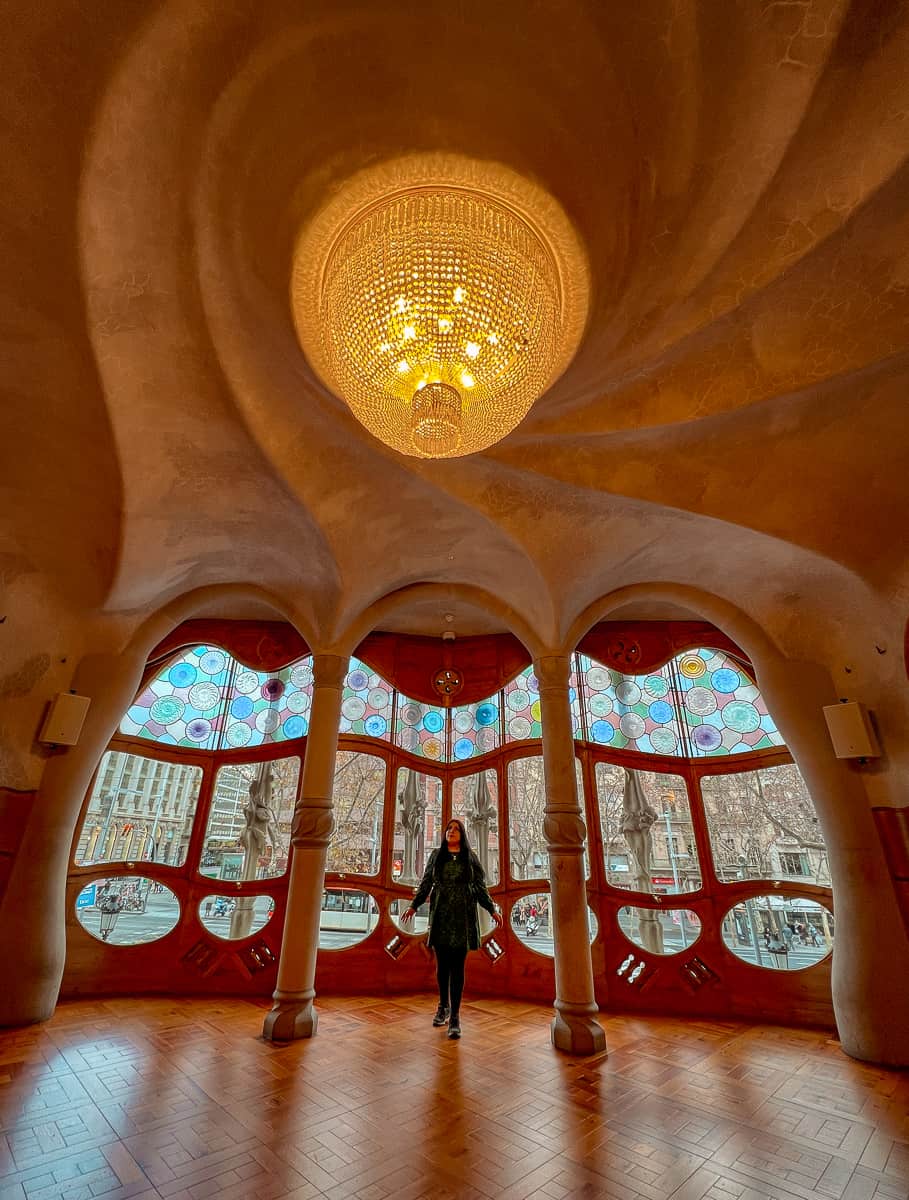
The colourful stained glass window overlooks the prestigious Passeig de Gràcia and has a swirling ceiling to support the sparkling chandelier.
You’ll pass by the spine-esque staircase of the house as well as many rooms of the Batlló family.
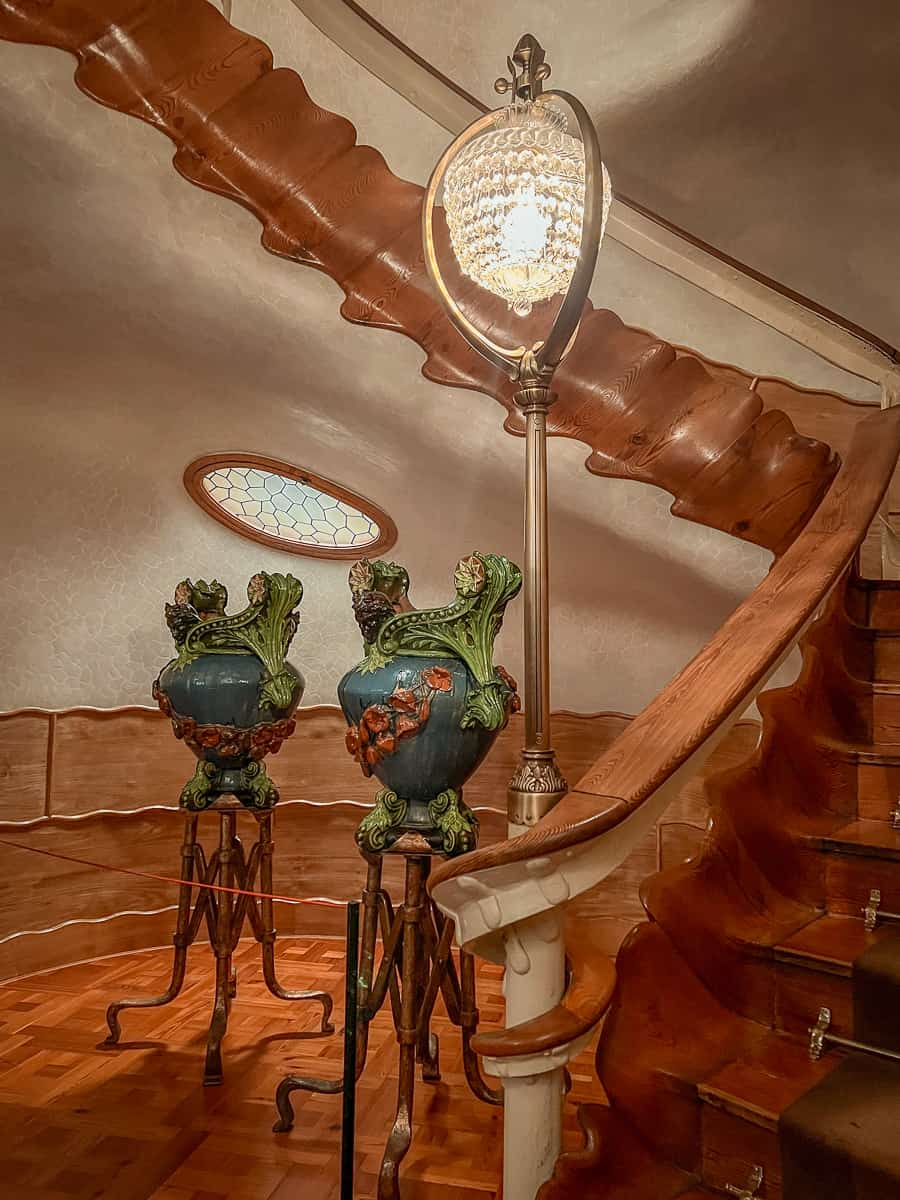
3. Hidden Garden
After you’ve explored this residential floor and the Batlló dining room, you’ll exit the house briefly to enter the secret garden.
It was a small private oasis in the city that the family used to enjoy. They used this space for dining and events on special occasions.
The entire space is decorated with all sorts of tiles, flower pots and murals. I particularly loved the colourful patterns on the rear side of the house.


4. Lightwell Staircase
Electricity was quite a new thing in Barcelona when this house was built and so many houses relied on natural lighting and oil lamps.
Gaudi made sure to create a huge staircase that was lit up naturally by the skylight on the ceiling of the residence.


He extended the patio so that the light reached every room and decorated in all sorts of blue tiles which helped distribute the light evenly.
This part of the house also acted as ventilation as this was an era before air-conditioning and there was even a lift installed to help with accessibility.
As you ascend, the views of the house from this balcony get better and better! They made fabulous photo opportunities.
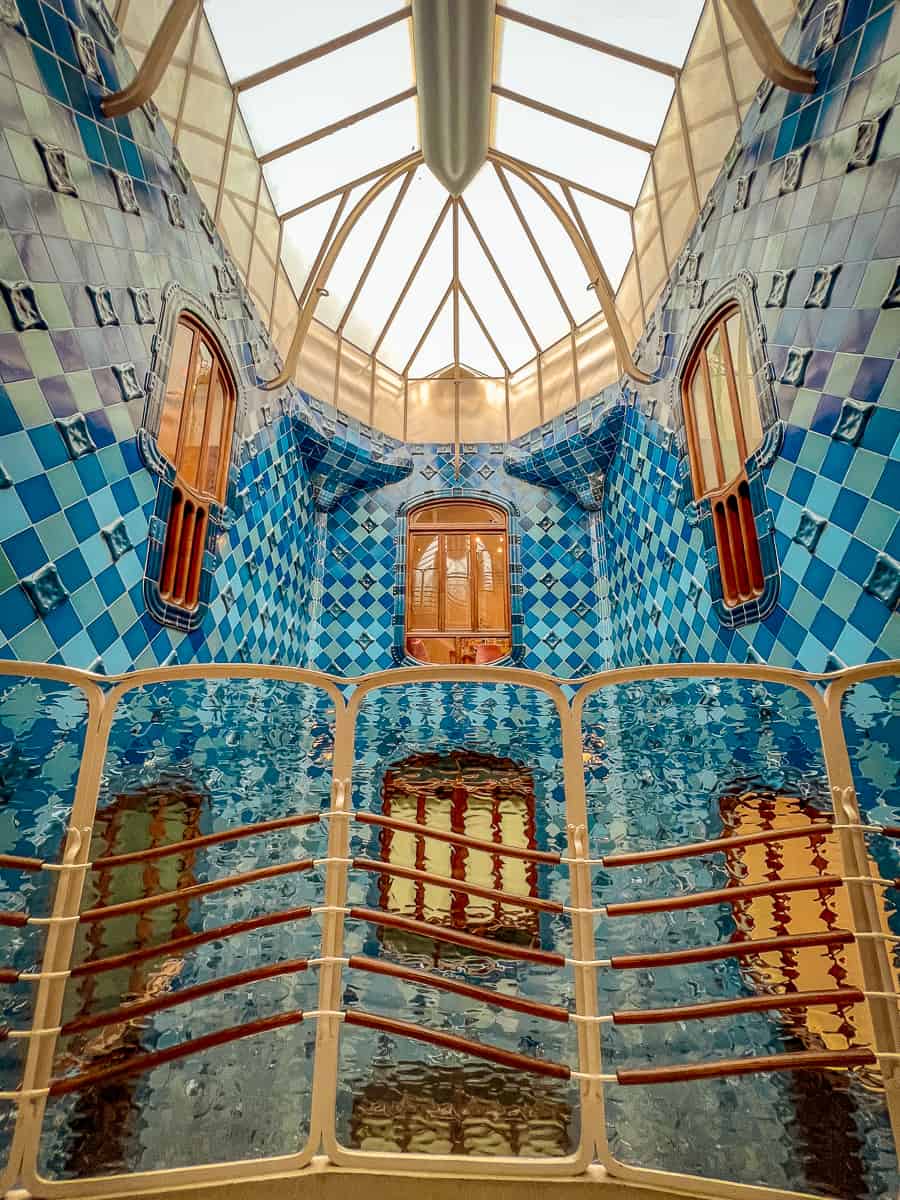
5. Rib cage Attic
At the top of the house, you’ll find the servant’s quarters which are in the attic. This area is again a great example of Gaudi’s genius.
It’s not only pretty but practical as it was an integral part of ensuring the efficient running of the household.
You’ll find it decorated with 60 catenary arches which look like a ribcage of a dragon!
As you make your way through, you’ll find many rooms that the butlers and maids used to work in as well as some modern immersive exhibitions.
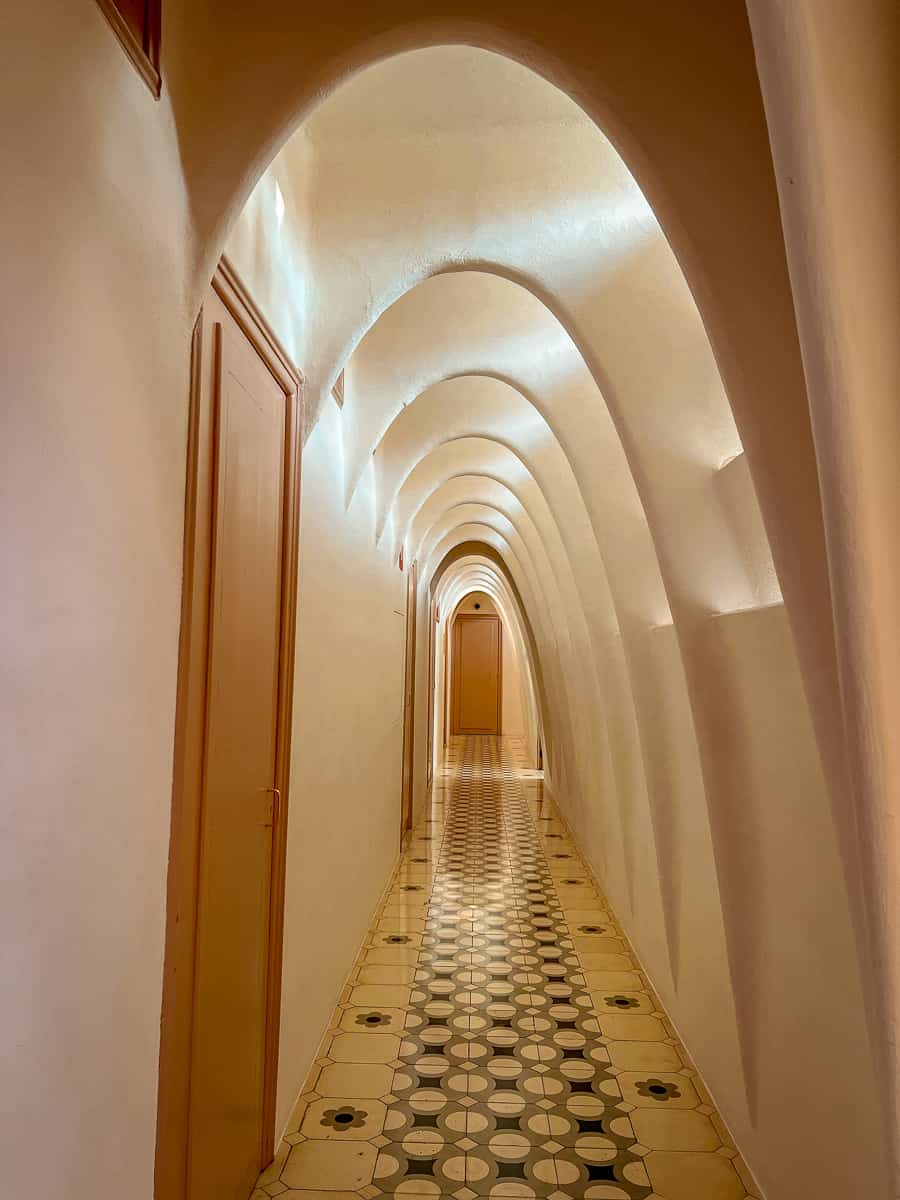
6. Rooftop Terrace
Once you’re through the rib cage, you’ll arrive on the rooftop terrace which provides magnificent panoramic views over Barcelona.
Also known as the ‘Dragon’s Back’, you’ll find many tiled chimneys here that are meant to represent the spikes of the dragon’s spine.
You can also take a closer look at St George’s sword and even poke your head through the dragon’s eye and peer at the tourists on the street level below.
Beneath the terrace, you can get a souvenir photo of you standing on the Princess balcony!


7. Stairs & Atrium
After the rooftop, you will walk down many stairs to the exit but even these staircases have been decorated with care.
The stairwells have been decorated in what looks like chainmail (an ode to St George?) and were created by Japanese architect Kengo Kuma.

8. Gaudi Cube & Dome
To finish your visit, you’ll leave through an immersive exhibition called ‘Gaudi’s Cube’.
It’s a 360-degree experience where you’ll be surrounded by screens and can experience “In the Mind of Gaudi” by Refik Anadol.
It was such a cool experience but what I would say is that it’s really trippy. I wouldn’t go inside if you have any sort of epilepsy or you’re prone to motion/cybersickness.

How to visit Casa Batlló in Barcelona
Casa Batlló can be found at 43 Paseo de Gracia which is in the centre of Barcelona and is seen as one of the most important streets in the city.
This area has been nicknamed the Manzana de la Discordia (Apple of Discord) as it’s a riot of architectural styles.
Next door to Gaudi’s home you’ll see Casa Amatller which is often overlooked for its shinier neighbour.
Although it looks like a Gaudi creation it was made by Josep Puig I Cadafalch for chocolatier Antoni Amatller.
Casa Battló is very easy to access via walking, bus or metro and is close to other famous Gaudi sites like La Pedrera / Casa Mila.
You can take the L2, 3, or 4 metros to Passeig de Gràcia and then it’s just a short walk from there.
If you’re using your phone to guide you. Click here for a Google Pin!

Opening times and ticket prices
Casa Batlló is open every day of the year which makes it really easy to plan a visit whilst you’re in Barcelona.
It’s usually open from 9 am – 6 pm but sometimes they have nighttime offers where they stay open as late as 10 pm.
The only thing I would say is that you should book tickets well in advance as they are known to sell out. It’s one of the most popular attractions in Barcelona.
They may have some tickets on the day but it’s never a guarantee and you could be queuing for a long time.
I would say to get there at 9 am sharp when the box office opens if you want to buy a ticket on the day.
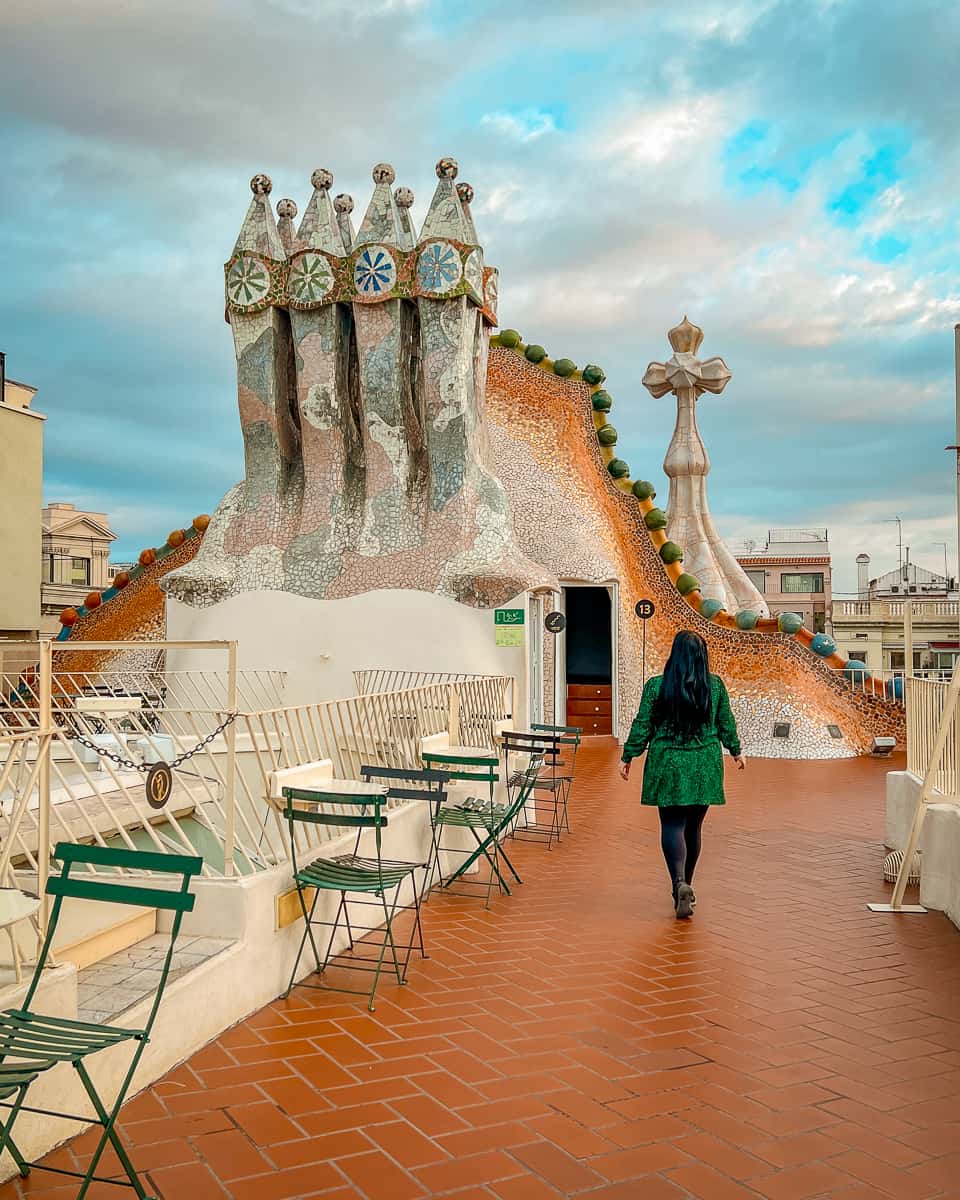
General entry is 35 euros per person but under 12s get to go inside for free. There are slight discounts for students and residents of Spain.
If you wanted to beat the crowds and get some incredible photos, I would visit for their ‘Be the First’ offer. It was a little more expensive at 45 euros but I thought it was worth every penny.
This is what I did and it meant that I got in before general access at 8.30 am with a ‘small group’ (it was well over 50 people) but I pretty much saw the house alone!

How long does it take to walk through Casa Batlló?
I would say that you need around 1-2 hours to explore Casa Batlló maybe more if it’s particularly busy or you love art, design and architecture.
As part of your visit, you get an audio guide which has a screen for augmented reality and this takes a while to go through.
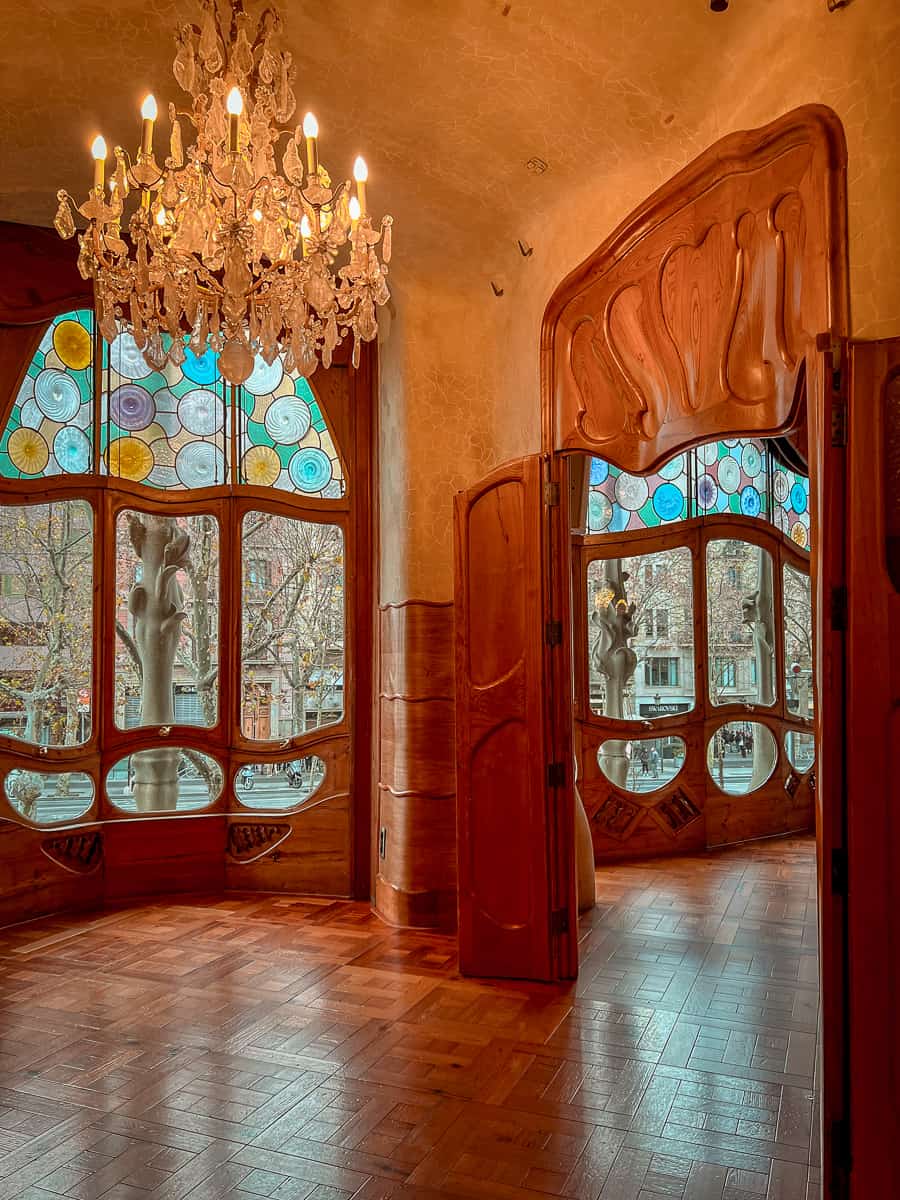
In each room, the audio guide plays music and shows you a fun video or animation of what the room was originally used for.
There’s also a beautiful rooftop to sit and admire the views plus a lot of immersive exhibitions you can get involved with.
Although you have a timed entry, you can spend as long as you wish here and I could have spent hours exploring this magical residence!

Is entering Casa Batlló worth it?
100% YES, Gaudi’s Casa Batlló is utterly magical and a must-visit if it’s your first time in Barcelona.
It’s a beautiful house that is based on a famous legend and is like a fairytale with its colourful artwork and innovative architecture.
It is quite expensive to go inside but I thought it was worth every penny as an art, history and architecture lover.
Don’t skip Barcelona’s House of the Dragon on your visit, you won’t regret a thing!

My top tips for visiting
- Go early – Casa Batlló can get extremely busy to the point where it’s suffocating. I’d recommend going early morning for the ‘be the first’ tour for a nicer experience.
- Book tickets in advance – there are many timeslots but they can sell out, especially in the summer season.
- Photography is allowed – you can take as many photos/videos as you wish. Even my tripod was allowed which was a welcome change.
- It’s accessible – Casa Batlló has made the entire house from basement to rooftop accessible for wheelchairs and easy for those who need a little extra accessibility. Make sure to enquire about the lifts before you start your tour as there are many steps.
- Leave a few hours – you will need at least 1-2 hours to explore this house. There’s lots to see!

Are you looking for more Gaudi attractions in Barcelona?
One of the most popular things to do whilst in Barcelona is to visit Antoni Gaudi’s houses and they all form part of a UNESCO World Heritage Site.
Although Casa Batlló is the most famous, there are plenty of others that you can visit in the city.
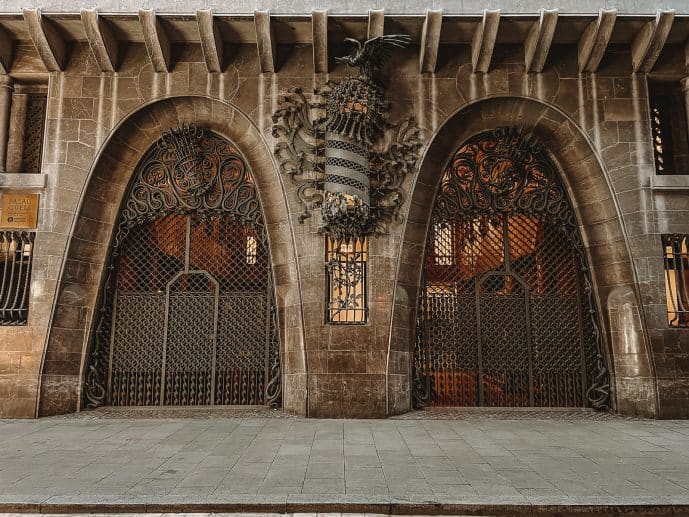
Casa Mila
The next place you can visit is Casa Mila aka La Pedrera which has an undulating facade.
Although considered a Gaudi masterpiece today, this building was hated by the locals of Barcelona until around the 1990s.
Today, it’s a very popular museum and residency. You can climb up to see their Warrior Rooftop for views over the city skyline.

Casa Vicens
I would also visit Casa Vicens which was Gaudi’s first residence project. The tiles and patterns here are gorgeous.
It’s not as well known as the other Gadui residences and so you will escape the crowds in this architectural oasis.
You can explore the restored house, visit the rooftop and have a relaxing coffee in their café.
Click here to read my complete guide for Casa Vicens

Sagrada Familia
One of Gaudi’s most famous projects is the majestic Sagrada Familia. It’s an intricate temple that was designed by Gaudi and started construction over a century ago in 1882.
It is still a work in progress today and is due to finish in this decade (hopefully). But, you can still go inside and explore what’s finished.
Although the outside of the building is a masterpiece, the interiors will take your breath away.
Top tip: One of the best views is from the bar at Sercotel Rosellon Rooftop!
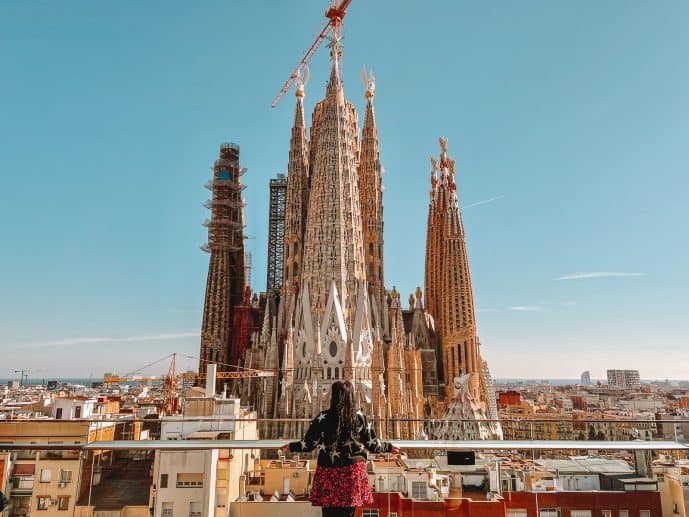
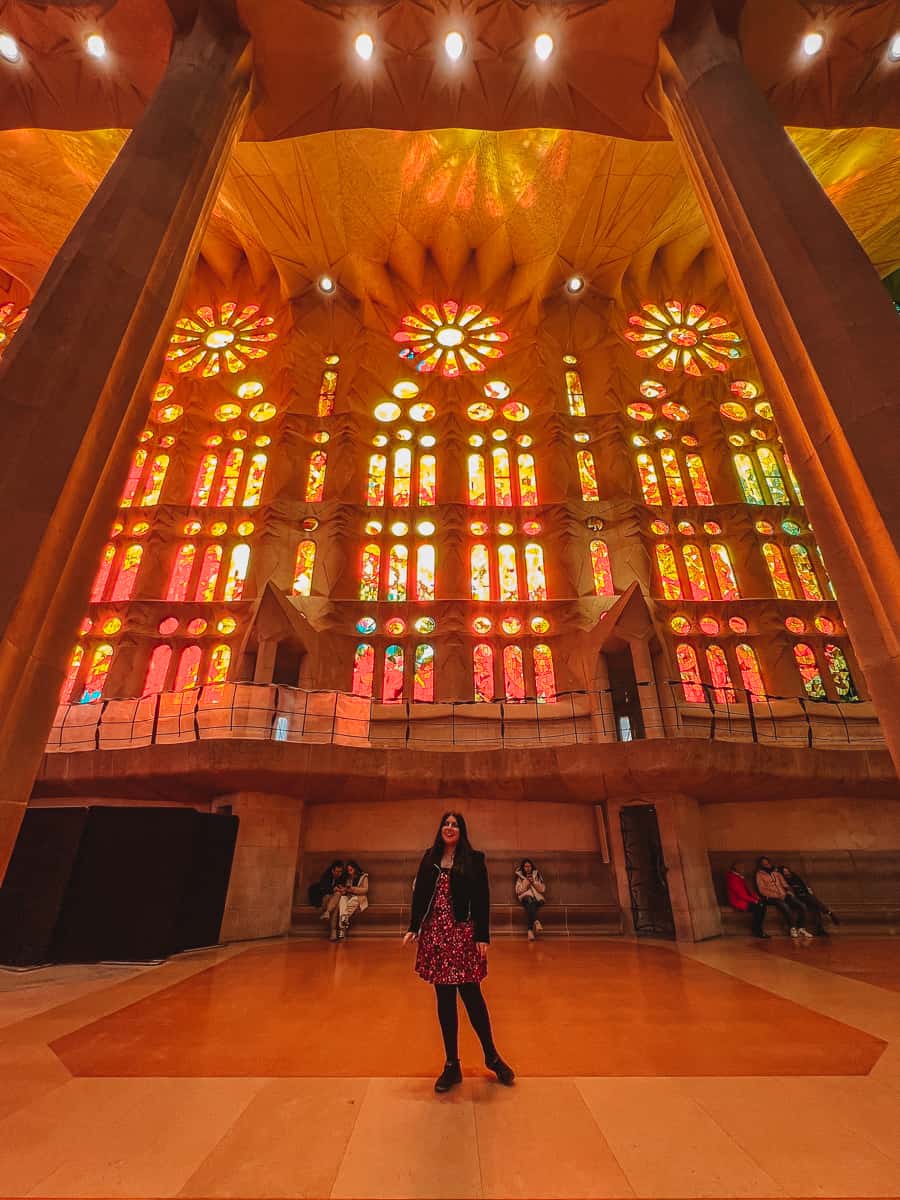
Other Gaudi sites in Barcelona
Although not a residence, you can visit Park Güell aka Gaudi Park which is another one of his creations and it’s located high up on Carmel Hill.
It has fabulous serpentine benches, the Hypostyle Hall and the Laundry Room Portico amongst other incredible pieces. Don’t forget to take a cheesy selfie with El Drac.
Whilst here you can also explore Gaudi’s House Museum, where he lived until he died.
Click here to read my post on all the things you can do in Park Güell
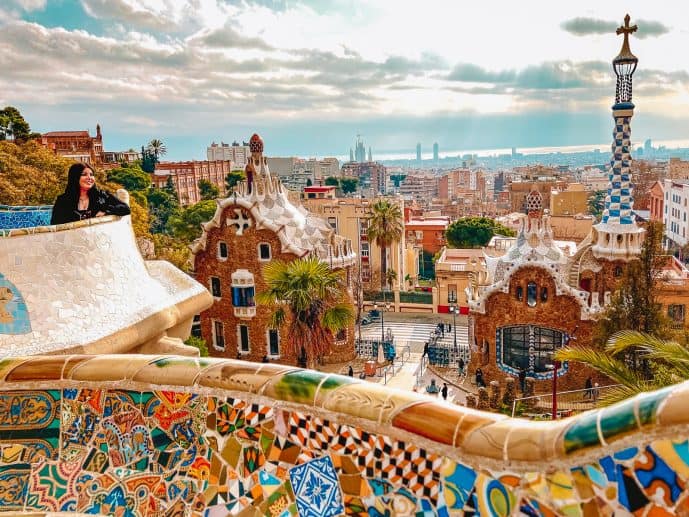
Palau Güell is another grand residence that Gaudi built for Eusebi Güell off La Rambla which has another incredible tiled rooftop.
Lastly, Cascada Monumental is also known as Gaudi’s Fountain! Although he didn’t design the fountain he did help with the hydraulics.
Regardless, it’s well worth visiting this incredible place in Parc de la Ciutadella. Ancient legends and mythological creatures inspired the design and it’s spectacular.
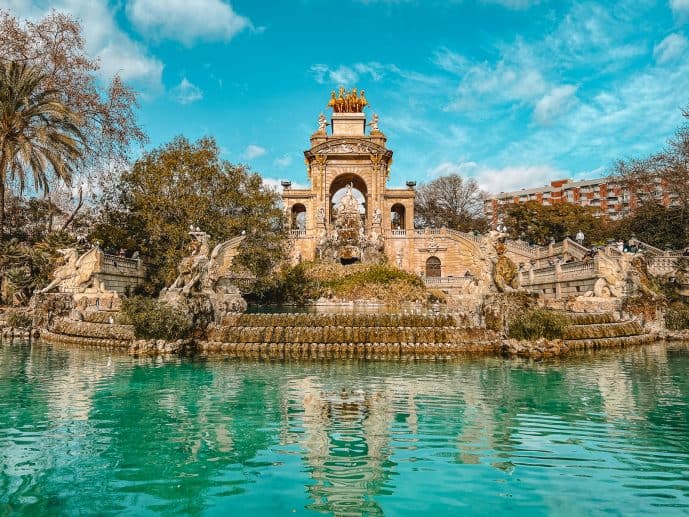
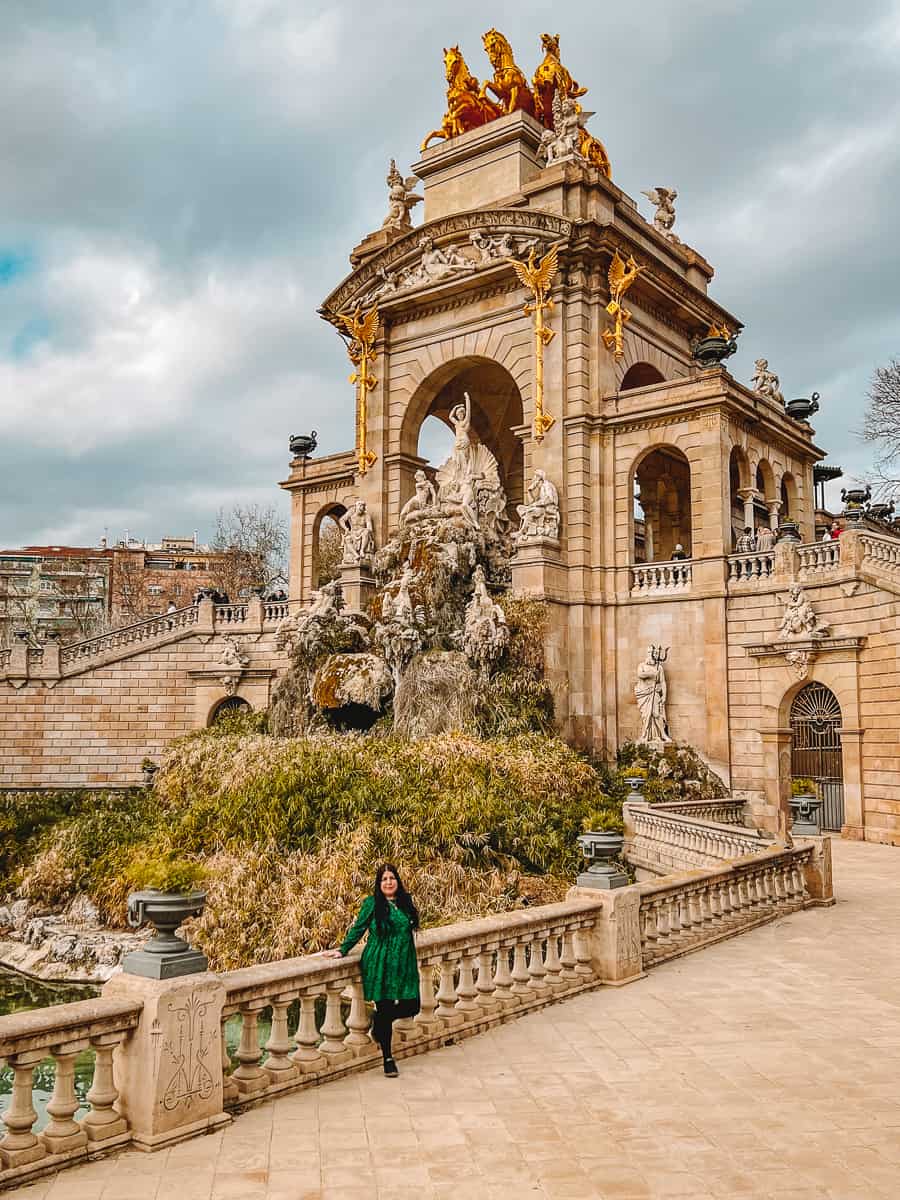
Read more of my Spain travel guides
30+ Instagrammable places in Barcelona
How to visit Bunkers del Carmel in Barcelona
The gorgeous Cascada Monumental
Discover Sant Pau Recinte Modernista
Secrets of Pont Del Bisbe Bridge
How to visit the Kiss Wall Barcelona
Why you must visit the Fairy Bar in Barcelona
You must visit Palau de la Musica Catalana
Archivo de Indias – Hidden Gem in Seville
How to visit Cordoba Mosque-Cathedral for free
Save Gaudi’s Casa Batlló Barcelona for later!

Here are some Spain travel resources
- Flights: I use Skyscanner to look for flight deals. Try to be flexible with travel dates for the best prices.
- Accommodation: Booking.com is my go-to hotel platform and I’ve used them for years.
- Public transport: You can book trains through the official Renfe site. Also, Trainline works and I found it cheaper on some journeys.
- Car rental: Rental Cars is a great choice that compares all sorts of rental companies and gets you the best price.
- Activities: I love GetYourGuide and use the platform all the time for booking group tours and attraction tickets.
- e-Reader: I love to read Romantasy books and I always take my beloved Kindle Oasis with me. It has an orange light and is waterproof which is perfect for lounging by the pool.
- Travel insurance: I always use World Nomads to book travel insurance. You never know when you’ll need cover!
